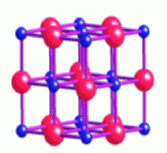Dr Emma Chung
|
|
||
|
|
|
 |
Dr Emma Ming Lin Chung was born in Hobart, Tasmania, in 1975. She read Physics at the University of Kent at Canterbury and went on to the University of Warwick to research for her Ph.D.; Studies of d-electron magnetism in single-crystal transition metal oxides. Emma now lives in Leicester working in Medical Physics.
Emma's Ph.D. consisted of travelling to picturesque neutron sources in France, Switzerland, the U.S.A., U.K. and Denmark, where she attempted (with varying success) to perform neutron scattering experiments on magnetic single-crystals. A brief description of her main research topics is provided below.
Li2CuO2 : "1-D analogue" of the High-Tc superconductors
| Lithium cuprate is described as quasi 1-dimensional in nature since the magnetic copper atoms form in chains which are widely separated by non-magnetic Li-O units. Although Li 2CuO2 has been intensively modelled using band structure calculations, the role of the Cu-O squares which makeup the chains is not presently understood, such as:
|
|
| Li2CuO2: The magnetic structure consists of chains of Cu2+ ions. |
2-dimensional magnetism in Tapiolite
|
|
Named after the god 'Tapio' of Finnish mythology, Tapiolite (FeTa2O6) is a naturally occurring mineral found in granite pegmatites. Since each magnetic Fe-O layer is separated by two layers of Ta-O atoms it was thought that FeTa2O6 might be be a good candidate for exhibiting 2-D magnetic behaviour. We recently confirmed the 2-D nature of the structure by observing diffuse rods of scattering resulting from the magnetic layers. Using inelastic neutron scattering it was also possible to measure FeTa2O6 spin-waves. Analysis of these results using a suitable model will help us to calculate the relative strengths of inter and intra-chain interactions. |
| FeTa2O6: The magnetic Fe2+ ions form 2-D planes. |
MnO and NiO: Classic 3-D antiferromagnets
| MnO and NiO are classic 3-D antiferromagnets, first studied using magnetic neutron scattering by Shull in the early 50's. (Work which was later to win him the Nobel prize for physics!). Recent theory suggests that the vibrations within the crystal lattice of antiferromagnetic MnO should be substantially non-cubic (despite the structure having a practically cubic electron density). By using inelastic neutron scattering we can measure the phonon frequencies along different directions in a MnO or NiO single-crystal. Splitting observed in the phonon spectra has confirmed the theory, however, the complex interplay between the magnetic, dynamic, and structural properties of these 'simple' magnetic materials are yet to be unravelled |
|
| MnO/NiO : Type II antiferromagnetism. |
Emma is now living and working in Leicester.
|
|
Content and figures by Emma Chung and Jim Hague.
Emma's Ph.D. publications
Thesis Abstract
Novel magnetic properties of d-electron single crystal oxides
Back to the Former Members of the Group
Emma is a British Heart Foundation Intermediate Basic Science Research Fellow based in the University of Leicester Department of Cardiovascular Sciences.
Intermediate Basic Science Research Fellow based in the University of Leicester Department of Cardiovascular Sciences.






